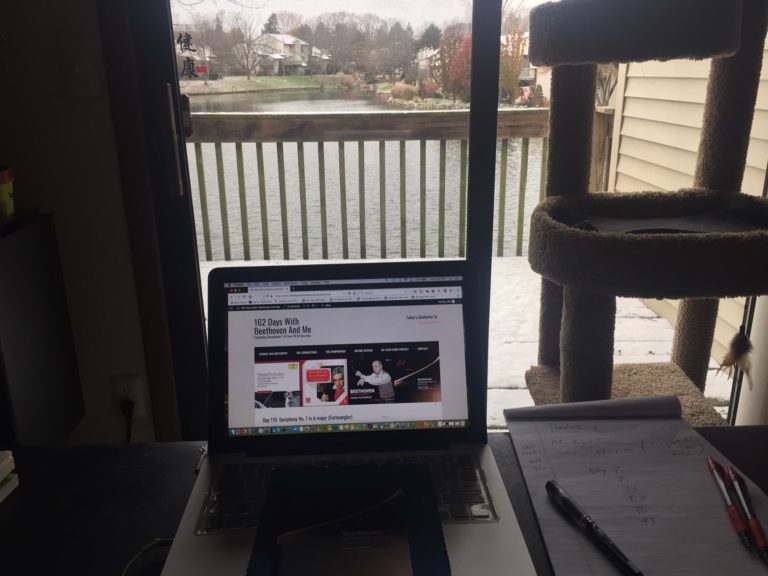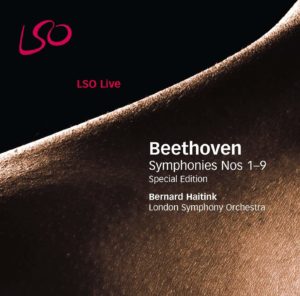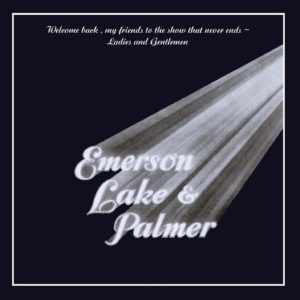
My listening post today is overlooking the lake on a bleak, cold, snowy early November.
The temperature is 28° (that’s -2°C to all my overseas friends). It may not be the coldest November in Michigan history. But it ranks right up there.
This winter is going to be a bitch.
Thankfully, it’s the perfect day to be indoors listening to Dutch conductor Bernard Haitink (1929- ), the London Symphony Orchestra, and Beethoven’s Symphony No. 7 in A major.
I have encountered Maestro Haitink six times previous to this bleak, cold day, on…
 Day 8. Rating:”Meh!”
Day 8. Rating:”Meh!”
Day 26. Rating:”Huzzah!”
Day 44. Rating:”Huzzah!”
Day 62. Rating: “Meh!”
Day 80. Rating: A very strong “Meh!”
Day 98. Rating: “Meh!”
What will this god-forsaken day bring?
I’ll know soon enough.
 Beethoven wrote his symphonies in four parts (except for the Sixth, which is in five). The time breakdown of this particular one (Symphony No. 7 in A major), from this particular conductor (Haitink, at age 76) and this particular orchestra (London Symphony Orchestra), at this particular time in history (November 17, 2005) on this particular record label (LSO Live) is as follows:
Beethoven wrote his symphonies in four parts (except for the Sixth, which is in five). The time breakdown of this particular one (Symphony No. 7 in A major), from this particular conductor (Haitink, at age 76) and this particular orchestra (London Symphony Orchestra), at this particular time in history (November 17, 2005) on this particular record label (LSO Live) is as follows:
I. Poco sostenuto – Vivace……………………………..13:24
II. Allegretto………………………………………………………7:41
III. Presto – Assai meno presto (trio)……………….9:05
IV. Allegro con brio…………………………………………..8:30
Total running time: 38:37
My Rating:
Recording quality: 5 (SACD 5.0 multi-channel recording, nearly perfect tone and quality, even the ambient sounds are clear as a bell)
Overall musicianship: 4 (a mixed bag)
CD liner notes: 5 (big booklet with lots of pertinent information and essays)
How does this make me feel: 3 (“Meh!”)
This is an extremely odd performance, hard for me to pin down whether I like it or not.
One thing I noticed right off the bat as I entered the running times for each track is that some movements have been elongated or truncated compared to Furtwangler’s.
For example:
Movement I is essentially the same running time (13:07 for Furtwangler, 13:24 for Haitink)
Movement II is widely different (10:14 for Furtwangler, 7:41 for Haitink)
Movement III is not much different between the two (8:40 for Furtwangler, 9:05 for Haitink)
Movement IV is another significant difference (6:55 for Furtwangler, 8:30 for Haitink)
Another thing I noticed is that in Haitink’s performance I’m hearing things that I didn’t hear in previous performances of Beethven’s Seventh. Without going back to compare each conductor’s performance, I can say that every movement sounds different to my ears.
For example:
Movement II (my favorite) sounds like it includes a fugue from 4:57-5:50. Now, that may be in every performance previous to this one. But I’m only hearing it now. Also, the ending seems different somehow. More emphasis on pizzicato.
Movement IV sounds like the brass instruments are more heavily favored. And the tempo sounds quite brisk.
I don’t know who makes the call when it comes to how a symphony is recorded (the record label? the engineer? the mixing/editing guru? the conductor?). But I do know this performance sounds like a different symphony to me. Oh, it’s reminiscent enough that I know it’s the same one. But, as I wrote, it’s different enough that I’m hearing things I hadn’t heard before.
And I know what that makes me think: acting.
I wrote a day or two ago that when I see actors acting in a movie or on TV I’m immediately taken out of the story. I cannot willingly suspend disbelief.
This performance by Haitink and the LSO sounds like acting.
By that, I mean that instead of the entire performance sounding like an orchestra in the groove – a singular powerhouse that blends instruments together to create something no one instrument could achieve.
Haitink’s performance of the Seventh sounds like a jazz band with each musician taking a solo now and then.
 Or Emerson, Lake & Palmer‘s live album titled Welcome Back, My Friends, to the Show That Never Ends ~ Ladies and Gentlemen, an astonishing triple-album release that remains one of my all-time favorites.
Or Emerson, Lake & Palmer‘s live album titled Welcome Back, My Friends, to the Show That Never Ends ~ Ladies and Gentlemen, an astonishing triple-album release that remains one of my all-time favorites.
I remember one review of the 1974 album that was in Circus or Creem magazines (I read them both religiously back then): “Everything but the kitchen sink.”
The reviewer referenced the wall of sound, that included synthesizers, keyboards, drums, bass, and enough weird sounds (mostly from Carl Palmer’s synthesized drum kit) that made it quite an interesting – and challenging – listen.
That’s a roundabout way of saying this recording highlights different instruments in a way that reminds me of ELP’s live album, with each musician taking a turn in the spotlight.
That’s not necessarily bad. I don’t mind different instruments and musicians take a turn in the spotlight. But, here, in this recording, it seems distracting in that it highlights passages I hadn’t noticed before – and not in a good way. It makes the passage and/or movement sound different.
In other words, instead of me hearing an orchestra play Beethoven’s Seventh, I’m hearing the orchestra. The fact that it’s Beethoven’s Seventh is a coincidence.
Again, I’m not sure why that is. How it was recorded may be 75% of matter. But it may be in how it’s conducted, too – which instruments Maestro Haitink chose to highlight.
I dunno.
I hate to give this a “Meh!” But it’s not “Huzzah!”-level, either.
I guess for this reason:
In other words, instead of me hearing an orchestra play Beethoven’s Seventh, I’m hearing the orchestra. The fact that it’s Beethoven’s Seventh is a coincidence.
I have to give this one a pass.
The playing is extraordinary. LSO is a tremendous orchestra, one of my favorites.
And maybe if I heard only this performance I wouldn’t be so harsh on it.
But I have heard other performances.
Compared to those, this one isn’t benchmark quality. I couldn’t recommend this as one that best repents Beethoven’s Symphony No. 7 in A major.
“Meh!”
